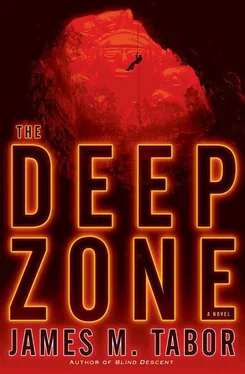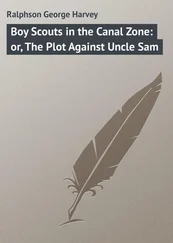“The only thing that helps is going up. So you’d have to ascend on your own until you felt better and wait for the rest of us to pick you up on the way back out.”
Arguello shuddered. “I do not know which would be worse,” he said. “Losing the mind or spending days alone in here waiting.”
“Hobson’s choice,” Hallie said, and could think of nothing worth adding. Nor, apparently, could the others. They stood around quietly after that, munching snacks, drinking from their poly bottles. After ten minutes, she spoke again:
“Let me brief you on the dive. We go in here. The entrance to the sump is like dropping down into a manhole for about twenty feet. Then the tunnel slopes at forty-five degrees, passing through the underwater face of that wall over there, drops to eighty feet, levels off, and continues straight for about two hundred feet. At that point, it makes a sharp turn to the right and narrows. If we were diving on conventional scuba, we’d have to doff our tanks and push them ahead of us. That’s how we got through on my first trip, and it was not fun. But with these new rebreathers, we should be able to pass through.”
“Wait a second. How narrow is narrow ?” Arguello sounded worried.
“After the right turn, the tunnel shrinks to about five feet in diameter. Big enough to pass through with the packs—barely—but not big enough to turn around in. Any problems before the halfway point, you have to back your way out. I don’t recommend it. It stays level like that for three hundred feet, then rises at an easy angle for about five hundred feet. That long, slow ascent takes care of any decompression obligation, so you won’t want to hurry there. You’ll surface in a place we named Grand Central Cavern.”
“About the rebreathers.” Bowman held up his own. “We briefed in Reynosa, but let’s do a quick check again. They have heads-up displays for all critical functions. Self-activating, triggered by submersion. Basically all you have to do is breathe and swim.”
“A couple of other things,” Hallie said. “The silt in here is really bad. We don’t have fins so we’ll be pulling with our hands, which means the last to come through are going to have zero viz, or close to it. But I’ll be going first and running a safety line, so you can maintain contact with that.”
“Actually,” said Bowman, “I’ll be going through first and running out the line.”
She gave him a look. “But I’ve been through here before.”
“I know that. But I’m expendable and you’re mission critical. We can’t afford to lose you. If there’s anything unexpected in the sump, it’s best I find it first.”
“Okay. You’re right.” She was annoyed, but could not argue with his logic.
“I’ve never seen rebreathers this small.” Ron Haight was holding his up, turning it over, examining it like some exotic treasure. “Most of ’em are like big suitcases.”
“They are. I mentioned that DARPA had a lot of things going. These are another. They’re half the size of standard rebreathers.”
“Do they use the same scrubbing system?”
“No. These use lithium trioxide to scrub the carbon dioxide from our recycled breathing gas.”
Cahner whistled. “Volatile stuff. Explodes if it gets wet.”
“But the best carbon dioxide scrubber there is, ounce for ounce.”
“I am just curious about one thing,” Arguello said. “How much does such a device cost?”
Bowman chuckled. “You don’t want to know.”
The unit was like no rebreather Hallie had seen or used. It had a full-face mask like those worn by commercial divers. The mask was connected by a short, flexible hose to a chest pack held in place by a webbing harness. The chest pack was about the size of an old Yellow Pages phone book and, with its lemon-colored plastic shell, looked something like one.
“Let’s get through this quickly.” Any wait longer than thirty seconds had Bowman sounding impatient. “These units do not have voice comm, so we won’t be able to talk to each other underwater. The packs’ weight should keep us negatively buoyant, so you won’t be pinned to the sump’s ceiling. I’ll dive first. Hallie next. Then Rafael, Al, and, Ron, you will be the sweep diver. Questions?”
Bowman looked around, his helmet light beam swinging from chest to chest. No one spoke. There was only the wind blowing through the cave, and the stream flowing, untold volumes of water folding and rolling down into the rocky throat, and the immense weight of darkness and depth pressing down on them.
Bowman took off his pack and helmet. He put his rebreather face unit on, tightened the black rubber straps behind his head, and snugged the chest pack tight. He grunted back into his pack and replaced his helmet. He took several test breaths, sat on the edge of the pool, and lowered himself carefully down into the water. He turned to face the rock, held the lip momentarily, and then disappeared beneath the surface. His helmet lights grew fainter, like candle flames slowing dying, and then they were gone.
Watching the lights fade, Hallie felt afraid. Not for herself. She had dived many such sumps—the Boneyard being a recent example—and they did not frighten her. But, somewhat to her surprise, the thought of losing Bowman so soon did—more than it should have, her rational side muttered. Then again, what did “should” mean? What needed to pass before she should feel that kind of fear for Bowman? Wrestling with such thoughts, she waited for the appointed five minutes to pass, and they passed very slowly indeed. She just wanted to get into the water and have this over with.
After donning her gear, she entered as Bowman had done. The water was cold—about sixty-five to seventy degrees Fahrenheit, she estimated—but not painfully so. They would not be submerged long enough to require wet suits. She lowered herself carefully beneath the surface, took a half dozen test breaths, and then let go of the rock. She sank slowly and her boots touched the sump’s silty bottom. She waited, double-checking the rebreather and getting her own respiration under control. Across the top of the glass faceplate, alphanumeric data glowed softly green:

DT was how much dive time had elapsed. Three hours was the rebreather’s maximum. Every minute of use would be depleting that from now on. PPO stood for partial pressure oxygen, the percentage of oxygen in her breathing gas. Anything over 1.8 could induce fatal toxicity. DIL was the amount remaining of diluent, the exotic chemical mix that scrubbed carbon dioxide from the air she breathed. DPT was her current depth. MXD was the maximum depth achieved on the dive. DIR was her compass heading, 313 degrees, or northwest, and BATT showed that the unit’s batteries were still at 100 percent capacity. DECO reported any danger of incurring decompression sickness, “the bends.” As long as it stayed green, she was good.
She dropped down the twenty-foot manhole, came to rest floating just above the silty bottom, and began pulling herself along. Each helmet had three lights. One was turned on for dry passages. For diving, they used all three. Hers bored luminous tunnels into the milky water. Viz was only about five feet. She knew Bowman would have tried to be very careful, but there was no way to avoid stirring up some silt. The cloudy water scattered her light beams so that it was like driving into thick fog at night. She kept going until the descending passage leveled off. There Bowman had tied off one end of the line from his caving reel to a projection in the rock, and she spotted it on the bottom of the sump right away.
Читать дальше













